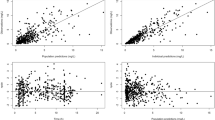Summary
The pharmacokinetics of i.v. chloramphenicol succinate and oral chloramphenicol palmitate were studied in Ethiopian children with different nutritional states. In children with kwashiorkor the plasma clearance of chloramphenicol was significantly lower than in children of normal weight (4.16 ml/min/kg versus 7.53 ml/min/kg). In consequence the mean half-life was prolonged (3.76 h versus 2.85 h) and this led to somewhat higher plasma levels in the kwashiorkor children. The influence of the pathophysiological changes offset one another so that plasma concentrations within the therapeutic range were obtained in children with kwashiorkor given recommended standard i.v. doses. The absorption of chloramphenicol after oral administration in severely malnourished children was erratic, which suggests that this route should be avoided in such patients.
Similar content being viewed by others
References
Meissner HC, Smith AL (1979) Pediatrics for the clinician. The current status of chloramphenicol. Pediatrics 64: 348
Lietman PS (1979) Chloramphenicol and the neonate — 1979 view. Clin Perinatol 6: 151
Black SB, Levine P, Shinefield HR (1978) The necessity for monitoring chloramphenicol levels when treating neonatal meningitis. J Pediatr 92: 235
Dunkle LM (1978) Central nervous system chloramphenicol concentration in premature infants. Antimicrob Agents Chemother 13: 427
Weiss CF, Glazko AJ, Weston JK (1960) Chloramphenicol in the newborn infant. N Engl J Med 262: 787
Windorfer A, Pringsheim W (1977) Studies on the concentrations of chloramphenicol in the serum and cerebrospinal fluid of neonates, infants, and small children. Eur J Pediatr 124: 129
Friedman CA, Lovejoy FC, Smith AL (1979) Chloramphenicol disposition in infants and children. J Pediatr 95: 1071
Sack CM, Koup JR, Smith AL (1980) Chloramphenicol pharmacokinetics in infants and young children. Pediatrics 66: 579
Kauffman RE, Miceli JN, Strebel L, Buckley JA, Done AK, Dajani AS (1981) Pharmacokinetics of chloramphenicol and chloramphenicol succinate in infants and children. J Pediatr 98: 315
Buchanan N (1978) Drug kinetics in protein energy malnutrition. South Afr Med J: 53
Krishnaswamy K (1978) Drug metabolism and pharmacokinetics in malnutrition. Clin Pharmacokinet 3: 216
Mehta S, Kalsi HK, Javaraman S, Mathur VS (1975) Chloramphenicol metabolism in children with protein-calorie malnutrition. Am J Clin Nutr 28: 977
Mehta S, Nain CK, Sharma B, Mathur VS (1981) Steady state of chloramphenicol in malnourished children. Indian J Med Res 73: 538
Editorial (1970): Classification of infantile malnutrition. Lancet II: 302
Wagner JG (1975) Fundamentals of clinical pharmacokinetics. Drug Intelligence Publications, Hamilton, Illinois, p 57
Narang RK, Mehta S, Mathur VS (1977) Pharmacokinetic study of antipyrine in malnourished children. Am J Clin Nutr 30: 1979
Homeida M, Karrar ZA, Roberts CJ (1979) Drug metabolism in malnourished children: A study with antipyrine. Arch Dis Child 54: 299
Buchanan N, Davis M, Danhof M, Breimer DD (1980) Antipyrine metabolite formation in children in the acute phase of malnutrition and after recovery. Br J Clin Pharmacol 10: 363
Levy G, Yacobi A (1974) Effect of plasma protein binding on elimination of warfarin. J Pharm Sci 63: 805
Tandon BN, Ramanujan RA, Tandon HD, Puri BK, Gandhi PC (1974) Liver injury in protein-calorie malnutrition: An electron microscopic study. Am J Clin Nutr 27: 550
Kunin CM, Glazko AJ, Finland M (1959) Persistence of antibiotics in blood of patients with acute renal failure. II. Chloramphenicol and its metabolic products in the blood of patients with severe renal disease or hepatic cirrhosis. J Clin Invest 38: 1498
Azzollini F, Gazzaniga A, Lodola E, Natangelo R (1972) Elimination of chloramphenicol and thiamphenicol in subjects with cirrhosis of the liver. Int J Clin Pharmacol 6: 130
Pickering LK, Hoecker JL, Kramer WG, Kohl S, Cleary TG (1980) Clinical pharmacology of two chloramphenicol preparations in children: Sodium succinate (iv) and palmitate (oral) esters. J Pediatr 96: 757
Yogev R, Kolling WM, Williams T (1981) Pharmacokinetic comparison of intravenous and oral chloramphenicol in patients with haemophilus influenzae meningitis. Pediatrics 67: 656
Author information
Authors and Affiliations
Rights and permissions
About this article
Cite this article
Eriksson, M., Paalzow, L., Bolme, P. et al. Chloramphenicol pharmacokinetics in Ethiopian children of differing nutritional status. Eur J Clin Pharmacol 24, 819–823 (1983). https://doi.org/10.1007/BF00607094
Received:
Accepted:
Issue Date:
DOI: https://doi.org/10.1007/BF00607094




